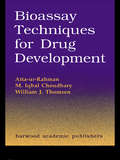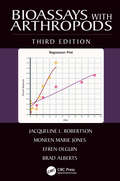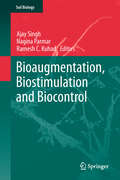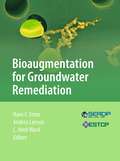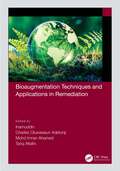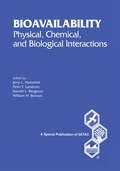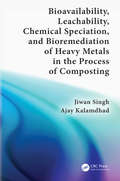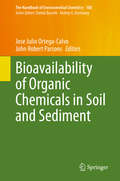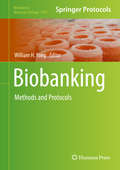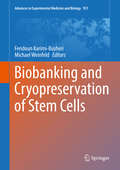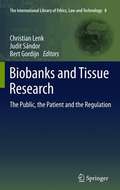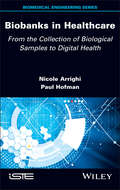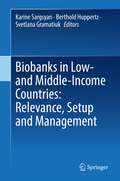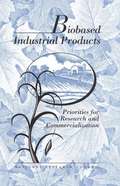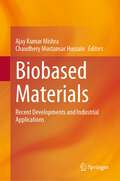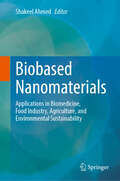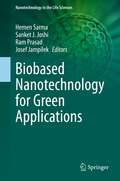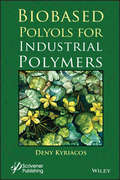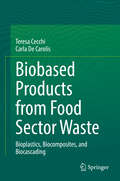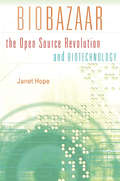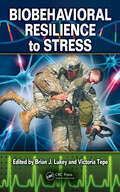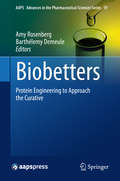- Table View
- List View
Bioarchaeology of Impairment and Disability: Theoretical, Ethnohistorical, and Methodological Perspectives (Bioarchaeology and Social Theory)
by Jennifer F. Byrnes Jennifer L. MullerOver the years, impairment has been discussed in bioarchaeology, with some scholars providing carefully contextualized explanations for their causes and consequences. Such investigations typically take a case study approach and focus on the functional aspects of impairments. However, these interpretations are disconnected from disability theory discourse. Other social sciences and the humanities have far surpassed most of anthropology (with the exception of medical anthropology) in their integration of social theories of disability. This volume has three goals: The first goal of this edited volume is to present theoretical and methodological discussions on impairment and disability. The second goal of this volume is to emphasize the necessity of interdisciplinarity in discussions of impairment and disability within bioarchaeology. The third goal of the volume is to present various methodological approaches to quantifying impairment in skeletonized and mummified remains.
Bioassay Techniques for Drug Development
by Atta-ur-Rahman M. Iqbal Choudhary William J. ThomsenThe goal of an activity-directed isolation process is to isolate bioactive compounds which may provide structural leads of therapeutic importance. Whereas the traditional process of drug development is long and expensive, simple and rapid bioassays can serve as the starting point for drug discovery. This book presents a range of "bench top" bioassa
Bioassays with Arthropods
by Jacqueline Robertson Moneen Jones Efren Olguin Brad AlbertsImagine a statistics book for bioassays written by a statistician. Next, imagine a statistics book for bioassays written for a layman. Bioassays with Arthropods, Third Edition offers the best of both worlds by translating the terse, precise language of the statistician into language used by the laboratory scientist. The book explains the statistical basis and analysis for each kind of quantal response bioassay in just the right amount of detail. The first two editions were a great reference for designing, conducting, and interpreting bioassays: this completely revised and updated third edition will also train the laboratory scientist to be an expert in estimation of dose response curves. New in the Third Edition: Introduces four new Windows and Apple-based computer programs (PoloJR, OptiDose, PoloMixture and PoloMulti) for the analyses of binary and multiple response analyses, respectively Replaces out-of-date GLIM examples with R program samples Includes a new chapter, Population Toxicology, and takes a systems approach to bioassays Expands the coverage of invasive species and quarantine statistics Building on the foundation set by the much-cited first two editions, the authors clearly delineate applications and ideas that are exceptionally challenging for those not already familiar with their use. They lead you through the methods with such ease and organization, that you suddenly find yourself readily able to apply concepts that you never thought you would understand. To order the PoloSuite computer software described in Bioassays with Arthropods, Third Edition, use the order form found at www.leora-software.com or contact the LeOra Software Company at leorasoftware@gmail.com.
Bioaugmentation, Biostimulation and Biocontrol (Soil Biology #10)
by Ajay Singh Ramesh C. Kuhad Nagina ParmarBioaugmentation, biostimulation and biocontrol approaches using microbial inoculants, biofertilizers, biochemicals and organic amendments improve soil biology, fertility and crop productivity by providing plant growth-promoting nutrients and suppressing soil-borne diseases and plant-parasitic nematodes. Our knowledge of microbial diversity and its function in soils has been increased tremendously due to the availability of a wealth of data gained through recent advances in the development of molecular methods and metagenomics for the evaluation of microbial diversity and functions in the rhizosphere environment of soil. Chapters dealing with the application of biofertilizers and organic amendments are contributed by experts - authorities in the area of soil science including microbiology and molecular biology - from academic institutions and the industry.
Bioaugmentation for Groundwater Remediation (SERDP ESTCP Environmental Remediation Technology #5)
by C. Herb Ward Hans F. Stroo Andrea LeesonThis volume provides a review of the past 10 to 15 years of intensive research, development and demonstrations that have been on the forefront of developing bioaugmentation into a viable remedial technology. This volume provides both a primer on the basic microbial processes involved in bioaugmentation, as well as a thorough summary of the methodology for implementing the technology. This reference volume will serve as a valuable resource for environmental remediation professionals who seek to understand, evaluate, and implement bioaugmentation.
Bioaugmentation Techniques and Applications in Remediation
by InamuddinIt has been observed that rapid population expansion has raised the amount of anthropogenic activity, resulting in high levels of pollution in water, air, and solid waste as well as an increase in the pressure placed on agricultural lands. Bioaugmentation Techniques and Applications in Remediation provides detailed information on bioaugmentation approaches for the remediation of sediments, water, and soil polluted with organic and inorganic pollutants. Practical applications of bioaugmentation techniques performed in restricted systems under controlled conditions, laboratory investigations, and in the field are addressed. Special emphasis is placed on the applications of nanomaterials in combination with bioaugmentation techniques for enhanced bioremediation efficiency. FEATURES Explores abiotic and biotic factors that enhance and facilitate environmental remediation of contaminants Provides a primer on the elementary microbial processes entailed in bioaugmentation Summarizes methods and approaches for executing bioaugmentation technology Details commercially available products and instrumentation This book is an ideal resource for researchers, students, and engineers working in materials science and bioremediation.
Bioavailability: Physical, Chemical, and Biological Interactions
by Jerry Hamelink Peter F. Landrum Harold Bergman William H. BensonPractical and provocative, Bioavailability reviews prevalent understanding of the physical-chemical-biological mechanisms that control the bioavailability of both organic and inorganic contaminants in aquatic environments.Discusses the complex issues that surround many regulatory issues Emphasizes the need to identify and control that portion of the total concentration that is biologically available and can cause adverse effects, i.e., "active" Examines the influence of dynamic factors, such as pH, alkalinity, and light on these mechanisms Addresses the subject of speciation for both organic and inorganic contaminants
Bioavailability, Leachability, Chemical Speciation, and Bioremediation of Heavy Metals in the Process of Composting
by Jiwan Singh Ajay KalamdhadCurrently, it is a serious concern to manage waste in the environment. Therefore, detailed knowledge of heavy metals, their eco-toxicological and health effects and ecofriendly approaches for their immobilization and detoxification is urgently required to control and minimize the environmental pollution. Composting is one of the popular methods in waste management and there are a lot of issues pertaining to composting. One of it is the leaching of heavy metals. This book discusses thoroughly, the availability, leachability and the speciation of heavy metals in the entire process of composting.
Bioavailability of Organic Chemicals in Soil and Sediment (The Handbook of Environmental Chemistry #100)
by Jose Julio Ortega-Calvo John Robert ParsonsThis book discusses bioavailability concepts and methods, summarizing the current knowledge on bioavailability science, as well as possible pathways for integrating bioavailability into risk assessment and the regulation of organic chemicals. Divided into 5 parts, it begins with an overview of chemical distribution in soil and sediment, as well as the bioavailability and bioaccumulation of chemicals in plants, soil, invertebrates and vertebrates (including humans). It then focuses on the impact of sorption processes and reviews bioavailability measurement methods. The closing chapters discuss the impact of bioavailability studies on chemical risk assessment, and highlights further research needs. Written by a multi-disciplinary team of authors, it is an essential resource for scientists in academia and industry, students, as well as for authorities.
Biobanking: Methods And Protocols (Methods in Molecular Biology #1897)
by William H. YongThis volume not only discusses various common biobanking topics, it also delves into less-discussed subjects such as what is needed to start a biobank, training of new biobanking personnel, and ethnic representation in biospecimen research. Other chapters in this book span practical topics including: disaster prevention and recovery; information technology; flora and fauna preservation including zoological fluid specimen photography; surgical and autopsy biobanking; biobanking of bodily fluids; biosafety; cutting frozen sections; immunohistochemistry; nucleic acid extraction; and biospecimen shipping. Written in the highly successful Methods in Molecular Biology series format, chapters include introductions to their respective topics, lists of the necessary materials and reagents, step-by-step, readily reproducible laboratory protocols, and tips on troubleshooting and avoiding known pitfalls.Unique and comprehensive, Biobanking: Methods and Protocols is a valuable resource for novice and practicing biobankers, and for end-user researchers. This book aims to bring new insight into the field and expand on current biomedical biobanking studies.
Biobanking and Cryopreservation of Stem Cells (Advances in Experimental Medicine and Biology #951)
by Feridoun Karimi-Busheri Michael WeinfeldBiobanking is considered to be one of the ten ideas changing the world with an estimated value of $45 billion by 2025. Despite the challenges, as the climate for innovation in the biobanking industry continues to flourish around the world, it is certain that amazing discoveries will emerge from this large-scale method of preserving and accessing human samples; biobanking is no longer just a place for collecting and storing samples. This book will cover a wide variety of subjects from across the future biobanking spectrum including scientific strategies, personalized medicine, regenerative medicine and stem cell challenges, disease surveillance, population genetics and innovative methods of biobanking.
Biobanking in the 21st Century: Volume I - Techniques (Advances in Experimental Medicine and Biology #864)
by Feridoun Karimi-BusheriBiobanking, an emerging field supported by academia, industry and health administrators alike, is distinctly different today from the practice that once defined it. The science of Biobanking, which initially involved simply storing blood or tissue samples in a freezer, is now a highly sophisticated field of research, and expected to grow exponentially over the next decade or two. This book aims to serve the purpose of further enriching the available literature on Biobanking, by offering unique and more useful collection of ideas for the future. The book outlines the experiences of developing modern Biobanking repositories in different countries, whilst covering specific topics regarding the many aspects of Biobanking. This book will be of interest to a wide range of readers including: academics, students, volunteers and advocates of patients' rights.
Biobanks and Tissue Research: The Public, the Patient and the Regulation (The International Library of Ethics, Law and Technology #8)
by Bert Gordijn Judit Sándor Christian LenkThe research field of biobanks and tissue research is highly promising. Many projects around the globe are involved in the collection of human tissue and health data for research purposes. These initiatives are driven by the perspective of decisive breakthroughs in the knowledge of the genetic pathways involved in widespread diseases. However, there are considerable ethical and legal challenges to be considered as well. These challenges encompass the use of body material for research purposes, the misuse of genetic and other health data by third parties, trust in science and medicine, concerns regarding privacy, use of genetic data for forensic applications by the state and the police, and regulatory issues. This volume is divided into three parts: the inclusion of the public, the rights of donors and patients, examples and recommendations for the future of tissue research. It presents a comprehensive overview of the most important topics in the field by renowned scholars in medical ethics and biolaw.
Biobanks in Healthcare: From the Collection of Biological Samples to Digital Health (ISTE Invoiced)
by Nicole Arrighi Paul HofmanBiobanks ensuring the governance and management of biological resources have become essential entities. The development of biotechnologies, the increased prevalence of biological drugs and the identification of biomarkers associated with molecular classifications of tissue lesions make it essential to have organized access to human biological samples, which have become precious and rare. The digital era and the production of massive data that comes with it have rendered biobanks the guarantors of the reproducibility of experiments and of the overall quality of medical research. Biobanks in Healthcare explores the upheaval linked to the massive deployment of digital health and precision medicine. The future of health biology lies in the deployment of biobanks in fields that have yet to be explored, putting them at the forefront of this extraordinary 21st-century research adventure.
Biobanks in Low- and Middle-Income Countries: Relevance, Setup and Management
by Karine Sargsyan Berthold Huppertz Svetlana GramatiukThis book introduces the fundamentals of biobanking and guides through the practical planning thereof, with a special focus on the situation in low- and middle-income countries. On the example of the setup of a Ukrainian biobank the book discusses the main steps and aspects of successful biorepository implementation and management. Topics covered include collection, storage and shipping of samples, establishment of an IT system, development of a sustainability plan, and project and risk management. Furthermore, the importance of the formation of international biobanking societies such as the Ukraine Association of Biobanks is highlighted, and their main objectives and tasks are discussed.The book addresses life science and business professionals as well as national authorities who are interested in biobanking in general and in setting up a biobank in particular.
Biobased Industrial Products: Priorities for Research and Commercialization
by National Research CouncilPetroleum-based industrial products have gradually replaced products derived from biological materials. However, biologically based products are making a comeback--because of a threefold increase in farm productivity and new technologies.Biobased Industrial Products envisions a biobased industrial future, where starch will be used to make biopolymers and vegetable oils will become a routine component in lubricants and detergents.Biobased Industrial Products overviews the U.S. land resources available for agricultural production, summarizes plant materials currently produced, and describes prospects for increasing varieties and yields.The committee discusses the concept of the biorefinery and outlines proven and potential thermal, mechanical, and chemical technologies for conversion of natural resources to industrial applications.The committee also illustrates the developmental dynamics of biobased products through existing examples, as well as products still on the drawing board, and it identifies priorities for research and development.
Biobased Materials: Recent Developments and Industrial Applications
by Ajay Kumar Mishra Chaudhery Mustansar HussainThis book discusses the extraction, purification, modification, and processing of biobased materials and their various industrial applications, across biomedical, pharmaceutical, construction, and other industries. It includes contributions from experts on hybrid biopolymers and bio-composites, bioactive and biodegradable materials, bio-inert polymers, natural polymers and composites, and metallic natural materials. Therefore, this encyclopedia is a useful reference for scientists, academicians, research scholars, and technologists. Major challenges of biobased materials are their efficient development, cost-effective, and green & environment friendly production/applications. This encyclopedia answers these challenges to professionals and scientists for proper utilization of biobased materials. It presents the recent practices of biobased materials technology in different scientific and engineering domains. It helps the bounded industrial outcomes to reach the general readership of different domains. This encyclopedia bridges the technological gaps between the industrial and academic professionals and the novice young students/scholars. The interdisciplinarity of this encyclopedia makes it unique for a wide readership. The topic of biobased materials is currently popular in the scientific community, working in such following areas as Recycled materials, Renewable materials, Materials for efficiency, Materials for waste treatment, Materials for reduction of environmental load, Materials for easy disposal or recycle, Hazardous free materials, Materials for reducing human health impact, Materials for energy efficiency, Materials for green energy, etc. This is a relatively hot topic in materials science and has strong demands for energy, material and money savings, as well as heavy contamination problems, despite that the area of biobased materials belongs to most important fields of modern science & technology, no important encyclopedias have been published in the area of “biobased materials”
Biobased Nanomaterials: Applications in Biomedicine, Food Industry, Agriculture, and Environmental Sustainability
by Shakeel AhmedThis book comprehensively covers various aspects of biobased nanomaterials, including their types, fabrication methods, characterization techniques, and applications in different fields. The book starts with an introduction to biobased nanomaterials, highlighting their significance in various fields due to their unique properties. The first few chapters cover the different types of biobased nanomaterials, their properties, and how they are extracted from various natural sources. The methods of fabrication of biobased nanomaterials are discussed in detail, including the techniques for controlling their size, shape, and composition. It then delves into the characterization of biobased nanomaterials, discussing the different techniques used to determine their properties, including their morphology, size, structure, and composition. The subsequent chapters explore the various applications of biobased nanomaterials in different fields such as environmental applications, wound healing, tissue engineering, food industry, agriculture, sensing technology, biomedical applications, and energy storage devices. The advantages of biobased nanomaterials over traditional nanomaterials are highlighted, including their biodegradability and sustainability. The environmental concerns associated with biobased nanomaterials, as well as the health and safety concerns, are also discussed. The book concludes by looking at the prospects of biobased nanomaterials and how they can contribute to sustainable development. Overall, the book is an informative and comprehensive book that provides a thorough understanding of biobased nanomaterials and their various applications. It is a valuable resource for researchers, students, and professionals in various fields such as materials science, chemistry, biology, and environmental science. alike.
Biobased Nanotechnology for Green Applications (Nanotechnology in the Life Sciences)
by Ram Prasad Hemen Sarma Sanket J. Joshi Josef JampilekInvestigation on biobased nanomaterials has provided new insights into the rapidly advancing fields of the biomedical and environmental sciences by showing how these nanomaterials are effective in biomedicine and environmental remediation. These particles hold tremendous prospective applications, and are likely to become the next generation of particles in these areas. As such, research is ongoing and the data generated should have the potential for a sustainable future in both the environmental and biomedical fields.This book presents important findings on the role of and identification of novel applications of biobased nanomaterials. Unlike other books in this field, this book focuses entirely on sustainable application and remediation in biomedicine and environmental science. The chapters are written in such a way as to make them accessible to the reader, and furthermore, the volume can be readily adopted as a reference, or used as a guide for further research.This project was based on recent research (the last 5 years) and developed through an extensive literature search. The editors have also compiled some advanced, outstanding texts that should be of benefit to graduate students in their research.
Biobased Packaging Materials: Sustainable Alternative to Conventional Packaging Materials
by Shakeel AhmedThis book provides a comprehensive and authoritative review of recent developments in bio-based packaging materials along with an array of their industrial applications. It offers an interdisciplinary approach, combining food engineering, polymer science, materials science, and sustainable aspects of bio-based materials with their synthesis, properties, characterization, and applications in packaging materials. The book encloses chapters covering fundamental concepts, manufacturing, properties, characterization, and interaction of bio-based materials. It also discusses topics related to the different usage of bio-based materials, their environmental impact, regulations, safety aspects, circular economy, challenges, and opportunities allied to bio-based materials. It is an essential resource for academicians, researchers, students, and professionals interested in exploring the potential bio-based materials in food packaging.
Biobased Polyols for Industrial Polymers
by Deny KyriacosThe replacement of polyols synthesized from petrochemical by polyols originating from natural products, notably from vegetable oils and animal fats, has been the subject of research projects for a number of decades. Very recently, however, the polymers industry has intensified its efforts to include the “green products”, such as biobased polyols, in applications already available in the market. Examples of such applications include polyurethane foams, elastomers and epoxides. This book describes the extraction of the natural constituents of several fruits and plants as well as their chemical conversion to polyols. In addition to the chemistry involved in the process, particular emphasis is attributed to their applications.
Biobased Products from Food Sector Waste: Bioplastics, Biocomposites, and Biocascading
by Teresa Cecchi Carla De CarolisAn increased demand for waste upcycling has prompted the food industry to become more efficient in its handling of waste. Efficient utilization of food waste is of concern to consumers, environmentalists, and policy makers. In the past, food waste has been used for the production of bio-gas and bio-fuels, fertilizers and animal feed. Biobased products from food sector waste: Bioplastics, biocomposites, and biocascading proposes an innovative use of food waste—as filler in a bioplastic matrix.The upcycling of food industry waste to produce new composites has a number of beneficial features, including (i) avoiding the cost of waste disposal; (ii) reducing bio-based composites price; (iii) avoiding using edible resources as a starting material for bio-based composites (to eliminate competition between biomass use for food, feed, and material use); (iv) producing a non-food bio-based output different from existing outputs (bio-fuels or bio-energy). The production of value-added items supports the development of a circular and sustainable economy in a thriving bio-based sector via the emergence of food value chains.The authors explore the safety of bio-based products. Using an evidence-based approach, they detail the volatile profile of biobased products and underline the absence of priority air pollutants released by fossil plastics, which pose a significant public health threat. The volume also delves into socioeconomic considerations and environmental concerns related to the upcycling of food by-products. Finally, the authors address how advances in digital technology can make food waste upcycling a negative-cost process.
Biobazaar: The Open Source Revolution and Biotechnology
by Janet HopeFighting disease, combating hunger, preserving the balance of life on Earth: the future of biotechnological innovation may well be the future of our planet itself. And yet the vexed state of intellectual property law—a proliferation of ever more complex rights governing research and development—is complicating this future. At a similar point in the development of information technology, “open source” software revolutionized the field, simultaneously encouraging innovation and transforming markets. The question that Janet Hope explores in Biobazaar is: can the open source approach do for biotechnology what it has done for information technology? Her book is the first sustained and systematic inquiry into the application of open source principles to the life sciences. The appeal of the open source approach—famously likened to a “bazaar,” in contrast to the more traditional “cathedral” style of technology development—lies in its safeguarding of community access to proprietary tools without discouraging valuable commercial participation. Traversing disciplinary boundaries, Hope presents a careful analysis of intellectual property-related challenges confronting the biotechnology industry and then paints a detailed picture of “open source biotechnology” as a possible solution. With insights drawn from interviews with Nobel Prize–winning scientists and leaders of the free and open source software movement—as well as company executives, international policymakers, licensing experts, and industry analysts—her book suggests that open source biotechnology is both desirable and broadly feasible—and, in many ways, merely awaiting its moment.
Biobehavioral Resilience to Stress
by Brian J. Lukey Victoria TepeMilitary service involves exposure to multiple sources of chronic, acute, and potentially traumatic stress, especially during deployment and combat. Notoriously variable, the effects of stress can be subtle to severe, immediate or delayed, impairing individual and group readiness, operational performance, and ultimately‘survival. A comprehensive co
Biobetters: Protein Engineering to Approach the Curative (AAPS Advances in the Pharmaceutical Sciences Series #19)
by Amy Rosenberg Barthélemy Demeule"Biobetters: Protein Engineering to Approach the Curative" discusses the optimization of protein therapeutic products for treatment of human diseases. It is based on the fact that though numerous important therapeutic protein products have been developed for life threatening and chronic diseases that possess acceptable safety and efficacy profiles, these products have generally not been reexamined and modified for an improved clinical performance, with enhancements both to safety and efficacy profiles. Advances in protein engineering, coupled with greatly enhanced understanding of critical product quality attributes for efficacy and safety, make it possible to optimize predecessor products for clinical performance, thereby enhancing patient quality of life and with the potential for great savings in health care costs. Yet despite such knowledge, there is little movement towards such modifications. This book examines engineering protein therapeutic products such that they exhibit an optimal, not just an adequate, clinical performance profile. Two product classes, therapeutic enzymes for lysosomal storage diseases (enzyme replacement therapies, ERT) and monoclonal antibodies (mAbs), are used as examples of what modifications to such proteins could be made to enhance clinical performance, "closer to a cure" as it were. For ERT, the key to optimizing clinical performance is to ensure the ERT is endowed with moieties that target the protein to the relevant target tissue. Thus, for Gaucher Disease, our best example of how to optimize an ERT to address a disease that manifests in specific target tissues (macrophages and monocytes), the enzyme has been extensively modified to target macrophages. For diseases such as Pompe Disease, largely a disorder of muscle, optimal performance of ERT will depend on endowing the enzyme with the ability to be taken up via the Mannose 6 Phosphate Receptor, and so one of the chapters in the book will discuss such approaches. Moreover, a major failure of biotechnology based products is to gain access to the CNS, a key target tissue in numerous diseases. Thus, a chapter has been devoted to strategies to access the CNS. Additionally, immune responses to therapeutic proteins can be highly problematic, eliminating the efficacy of life saving or highly effective protein therapeutics. This is especially poignant in the case of Pompe Disease wherein great improvement in muscle strength and functionality is lost following development of an immune response to the ERT with consequent patient deterioration and death. Thus, a chapter regarding protein engineering, as well as other non-clinical approaches to diminishing immunogenicity is a valuable part of the book. Monoclonal antibodies (mAbs) can be engineered to bind targets relevant to a wide variety of diseases; binding affinity, however, is only part of the equation and one of the chapters will present a molecular assessment approach that balances affinity with pharmacokinetics and manufacturability. As with other proteins immunogenicity can be problematic, being responsible for loss of efficacy of anti-TNF mAbs, often after prolonged successful treatment. The authors will also share their perspective on the consequences of physico-chemical modifications occurring to mAbs once they reach the circulation or their target, a research area open to further development from a protein engineering as well as analytical perspective. This book will also discuss novel platforms for protein therapeutics, technologies that exceed mAbs with respect to potency, and hence, potentially efficacy. These platforms consist largely of repeat domain proteins with very high affinity for their target ligands, but while potentially more efficacious, immunogenicity may be a major problem limiting use. The economics surrounding the issue of biobetters is another high-profile issue - this final chapter will explore the incentives and disincentives for developing biobetters and consider incentives that might make their pursuit more rewarding.

